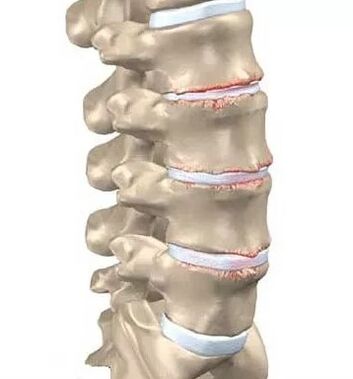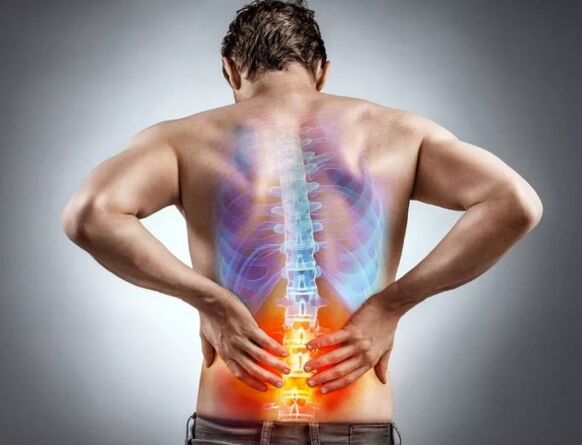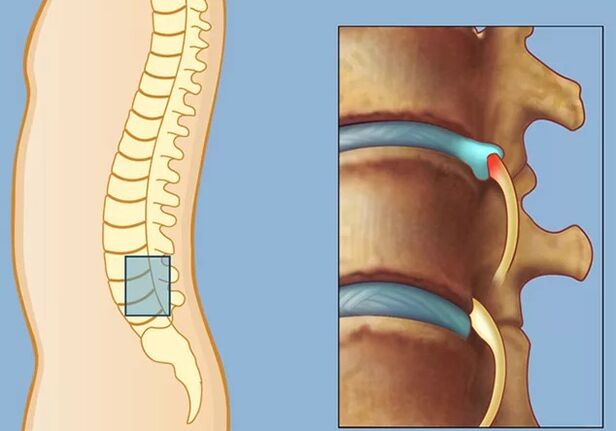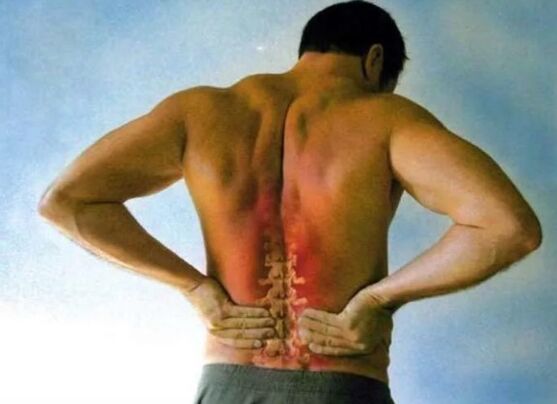Lumbar spine osteochondrosis is a disease that is a special form of spinal cord damage. Patients with such a disease complain of rapid fatigue, back pain, foot, which causes motor activity limit. With osteochondrosis, there is a deformity of the intervertebral discs, there is a decrease in height, dystrophy and their koracoid growth of vertebrae. When diagnosing radiographs, dischans are clearly visible.

Deformation of cartilaginous tissue during the development of osteochondrosis is a complex process, including biochemical and vascular changes. First of all, the fibrous ring is destroyed, as a result of which the pulosed is inserted into it. As a result, the fibrous ring is torn and the disc herniation is formed. In this case, the lower glossy segment and the lower boyfriend is subject to the highest load. The disc herniation, by squeezing the spinal cord or its roots, becomes the cause of back pain, which respond to the legs.
The most powerful sciatica in the human body is formed by the sacred roots of the spinal cord. They are, as well as the lower lover, irritated with osteochondrosis. From the Latin name of the sciatica, in this regard, the second name of the disease - Ishias was formed.
Due to the violation of the cartilage fabric structure, the intervertebral discs, which are special cartilage structures, can no longer fulfill all their functions in full. This leads to the loss of spinal flexibility and mobility. Processes, which in the early stages of the disease only affect intervertebral discs, gradually applies to the vertebrae itself.
Discogenic radicolitis, which is considered one of the most common symptoms of osteochondrosis, is found in almost every fifth person older than 30 in the world. At risk, working age people are most often at risk. Osteochondrosis deprives the ability to get involved in active activity and often causes disability.
Symptoms of lumbar osteochondrosis
The main symptoms of lumbar osteochondrosis are severe back pain. However, in addition to this sign, there are a number of others. So patients suffering from this disease quickly tired, complain of headaches, fatigue and irritability. The embarrassment on the back does not allow you to choose a suitable sleep position, so the body cannot rest completely and heal after the end of the day. Loss of force forces the patient to minimize physical activity and avoid pain. This leads to the fact that over time it becomes unable to perform simple actions, for example, to ensure its home needs.

Problems in the work of the genitourinary system can also be one of the symptoms of lumbar osteochondrosis. They appear in the form of pain in the kidney area. In patients with osteochondrosis, urination breaks down, sudden appearance of discomfort without cause is possible. This leads to the instability of the vertebrae, which due to deformation are not fixed by intervertebral discs. The load on the back provokes the relocation of the middle department from the sacrum when the gravity of force is exposed to it. Such a process leads to damage to the internal organs, problems in their work. In women, ovaries, supplements and uterus more often suffer, and power is worried about men.
Osteochondrosis is characterized by an increase in the sensitivity of the legs, including stopping, thickening and lower legs. They are cramps that can lead to complete loss of pulse. The patient's skin with osteochondrosis in the leg is very dry, peel and goose covered in the area of disturbance. During periods of pain, sweating is disturbed.
All symptoms of osteochondrosis can be classified into the following groups:
Novice syndrome
Adjustment of intervertebral discs leads to loss of stability beads. By becoming removable, they begin to bother and squeeze the blood vessels and nerve roots with sharp movements and severe physical exercises. This process minimizes pain in the lumbar region, but they resume with renewed energy, where the nerve is compressed. The pain is acute and is piercing. The discomfort is mostly expressed in the lower leg, thigh, leg and buttocks. Unpleasant sensations make the patient change walking, relying on the opposite side of the nerve.
When the nerve roots irritate for a long time, their inflammation, swelling, venous stagnation and intoxication occur. The pain applies to muscles, ligaments. It is more acute in moments of physical activity, especially if performed without more warm immediately after sleep or a state of rest. Pain is often associated with increased sweating, which replaces the feeling of chills.
Manifestations of radical syndrome also include tingling, numbness and loss of sensitivity. Muscles lose their tone, so patients are unable to endure long -term physical activity, for example, to descend and raise the stairs, quickly tired. The pelvic functions are terminated in particularly severe cases. In this case, both the emergence of paralysis and paresis is possible.
Ischemic syndrome
The roots near the nerve are the blood vessels, which are compressed during deformation. In the early stages of the development of osteochondrosis, the arteries are periodically squeezed, but then a spasm acquires a constant character. In this case, there is a "Lome drip", the patient often has to stop and rest with long walking.
Closing blood vessels leads to the fact that the pelvic organs do not receive the necessary nutrients. This causes pain in the inner part of the buttocks, perineum, in the buttocks to their paralysis.

Under the influence of pain, ischemic and radical syndrome, the patient's skeleton with osteochondrosis is deformed. A person begins to dive, he has a pelvis and spine, muscles weaken, atrophy. All of these changes affect walking, which is regulated depending on the pain area, becomes tense and unsafe. Gradually, the entire skeletal muscle system is exposed to osteochondrosis, and the intervertebral discs continue to collapse.
Pain syndrome (pain with lumbar osteochondrosis)
Unpleasant sensations and discomfort in the back are the main symptoms for osteochondrosis. The nature and strength of the pain varies depending on the stage of development of the disease.
At first, it is felt only in the lumbar region at the time of increased tension of joints, muscles and ligaments, that is, when performing physical exercises. It can also be persistent pain. But with the development of osteochondrosis, acute pain or change occurs with sneezing, coughing.
Palpation, as a rule, allows you to determine the seal in the muscles. A pain attack can last several days, and all this time the patient should observe bed rest in order to minimize unpleasant sensations in the back. Anydo sharp movement, weight lifting provokes discomfort.
Causes of lumbar osteochondrosis
The following main reasons for the development of lumbar osteochondrosis are distinguished:

Lumbari osteochondrosis rate
There are 4 degrees of Lumbar osteochondrosis:

Spinal deformity is formed by lordosis, kyphosis or scoliosis. With lordosis, the spine turns forward. Such a violation of its normal position greatly complicates the work of the internal organs and their systems. With kyfosis, the upper pole is curved, and a sensation of stooping occurs in advanced cases. Side bending manifests in the form of scoliosis. When a patient suffering from osteochondrosis with such a curvature of the spine bends forward, asymmetry becomes apparent thanks to the blade or prolonged ribs;





































